... The first thing a consumer needs to understand is that gemstones are graded by the rarity of their features. Even though we use the term "quality" that does not necessarily mean that one gem is better than another. On the contrary, what is best for you personally may not be the top, or rarest grade of a gem.
... When a mineral deposit is found there will be a wide variety of qualities. For example, let's say someone just mined 100 pounds of amethyst. One of the first things the grader will notice is the size variation. The smaller stones will settle to the bottom of the pile and the larger ones will demand the most attention. There are fewer large stones, so they will receive a higher grade in the size category than the smaller ones.
... A 100-carat stone is much less common than a one-carat stone and that feature will add to its value. However, simply being larger does not mean that it is better. A small woman could not wear a huge stone gracefully. This would not be the best gem for a small person.
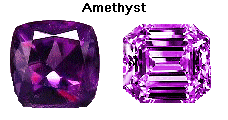 ... The same principle applies to the other grading factors as well. As the grader goes through his gems, only a few of the amethyst will have the absolute deepest and richest coloring. These will demand special attention and special pricing. However, the boldest colored stones are not the best match for every complexion, or every personality. Pastels are more feminine than bold colors and will suit some people much better.
... The same principle applies to the other grading factors as well. As the grader goes through his gems, only a few of the amethyst will have the absolute deepest and richest coloring. These will demand special attention and special pricing. However, the boldest colored stones are not the best match for every complexion, or every personality. Pastels are more feminine than bold colors and will suit some people much better.... So, as you read the following descriptions understand that the grades have to do with the rarity of the feature. They do not mean more durable, (with a single exception,) more beautiful, or better suited to your needs. When choosing a gem, look for the one that will give you the most enjoyment.
Color
... Colors are described by three factors:- Hue, (red, green, blue, etc.)
- Saturation, (strong or pastel, red or pink.)
- Tone, (light to dark.)
 ... Generally speaking, highest values go to stones with pure hues and strong rich colors. With high value gems, subtle variations make a significant difference in price. For example, a slightly orangish ruby will not be worth nearly as much as one that is pure red. Most people cannot see the difference, but to the expert grader it is significant.
... Generally speaking, highest values go to stones with pure hues and strong rich colors. With high value gems, subtle variations make a significant difference in price. For example, a slightly orangish ruby will not be worth nearly as much as one that is pure red. Most people cannot see the difference, but to the expert grader it is significant.... On moderate priced gems, color has less affect on value. For example, tourmaline comes in every possible color. Unless it is an exceptionally pure green, red or pink, they are all about the same value. It is the other factors of size, clarity and cutting that determine the gem's value.
... Diamonds are graded on how close they are to being colorless. There are three grades of "colorless" that only vary by subtle differences in transparency. Then there are four grades of "white." These are gems that will appear colorless when set in jewelry. It takes an expert in a laboratory setting to distinguish between these grades, but each represents a change in value.
... The color that is best for you is a personal matter. Strong, bold colors correspond with strong personalities; others prefer something softer and brighter. The color of your complexion and the color of the clothing you prefer also have a significant effect on your gem choice.
... To find what colors are best for you, look at a lot of gems. You will find that subtle variations in color can have a significant affect on both how they look on you and your emotional reaction to them.
... If you are a connoisseur of fine gems, the higher grades are significant. On the other hand, the average consumer will find just as much beauty in the more modestly priced stones. Remember, quality does not mean better, it means rarer.
Clarity
... Gemstones contain a wide variety of "inclusions." In a faceted gem, an inclusion is defined as anything that will interfere with the free passage of light. They can be little bits of minerals, hollow areas, or fractures.... As with color, tiny differences which are only apparent to the grader have a significant affect on value. The best examples of this are diamonds. There are several grades where the inclusions are invisible to the naked eye and have no affect on the beauty of the stone. Yet the difference in value, between something that is very difficult for an expert to find with 10 power magnification and something that is easy to find with magnification, is substantial.
... Most colored stones are simply graded "eye clean," (meaning that the inclusions are not visible to the naked eye,) slightly, moderately, or heavily included. Gems with eye visible inclusions are always lower in value, but the change is not applied equally. There are three classes of colored stones, those that are "usually clean," those that are "usually included," and those that are "almost always included."
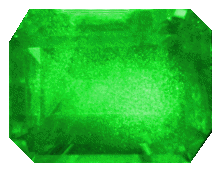 ... Emeralds fall into the last category. Their clarity cannot be compared with other gems. If you want an emerald without any eye visible inclusions, you are limited to small stones. If you want a larger emerald, you will have to accept a certain amount of inclusions and find its value in the color.
... Emeralds fall into the last category. Their clarity cannot be compared with other gems. If you want an emerald without any eye visible inclusions, you are limited to small stones. If you want a larger emerald, you will have to accept a certain amount of inclusions and find its value in the color.... If this does not appeal to you, then look at other green stones, like tourmaline and diopside. Their color can equal that of fine emeralds, without the inclusions, and at a much lower price. Now your choice is between having the name "emerald" or the premium color.
... Eye visible inclusions always have an affect on value. Sometimes this can be used to your advantage. I remember one young woman showing off her engagement ring. She had me look real close to see three tiny black dots. By accepting those small inclusions, which could not be seen from more than six inches away, her fiancé was able to afford a much larger diamond.
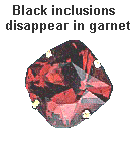 ... You will find just slightly visible inclusions in colored stones as well. Even some stones that are moderately included, like dark garnets, will look fine from the distance jewelry is usually viewed from. It is up to your personality to determine if it is going to affect the joy you get from the stone.
... You will find just slightly visible inclusions in colored stones as well. Even some stones that are moderately included, like dark garnets, will look fine from the distance jewelry is usually viewed from. It is up to your personality to determine if it is going to affect the joy you get from the stone.... While beauty is in the eye of the beholder, you need to pay special attention to fractures and veils. They represent a weakness in the gem and are prone to breakage. Earrings, pendants and brooches do not receive much abuse, but ring stones are subjected to a constant onslaught of bumps and bangs. If you intend a gem for a ring stone, you should be particularly cautious of a weak gem.
... Finding these types of inclusions in a gem, and determining their affect on its integrity, is difficult for the lay person to do. The old advice, "If you don't know your gems, know your gemologist," applies here.
Cut
... The cut of a gemstone, the workmanship that went into fashioning it, is one of the most important factors in its appearance. It is also one of the most difficult factors for the non-professional to judge because of the number of variations involved.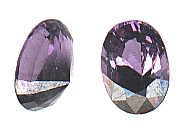 ... The first thing to do is to look at the shape of the stone. Some gems are cut "freeform" but most are intended to be a regular shape. If so, look at the symmetry. Does it bulge here or there, or is it symmetrical in all directions. Look at the stone from the side and the ends. Again, it should be symmetrical in all directions. If not, it is up to you to determine how much it will affect your appreciation of the stone.
... The first thing to do is to look at the shape of the stone. Some gems are cut "freeform" but most are intended to be a regular shape. If so, look at the symmetry. Does it bulge here or there, or is it symmetrical in all directions. Look at the stone from the side and the ends. Again, it should be symmetrical in all directions. If not, it is up to you to determine how much it will affect your appreciation of the stone.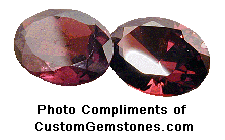 ... When considering a gem, insist on inspecting it with magnification. Look at areas where light is being reflected from the surface. They should be smooth and mirror like. If you see pitting, scratches, or dull areas, the gem is not well polished. It may look good in the store, but someday you will compare it with a well polished gem and be disappointed with your purchase.
... When considering a gem, insist on inspecting it with magnification. Look at areas where light is being reflected from the surface. They should be smooth and mirror like. If you see pitting, scratches, or dull areas, the gem is not well polished. It may look good in the store, but someday you will compare it with a well polished gem and be disappointed with your purchase.... If it is a faceted gem, look at the facets junctions also. On a well cut stone, they will be crisp and come together in a single point. You may see facets that are slightly rounded and not quite meeting where they should. Just how far off they are will affect the brilliance of the gem.
... The other factors in a faceted gem are too complex for the lay-person. However, you can get a good idea of the cutting quality simply by comparing it with other gems. When you do this, make sure you are comparing similar stones. An amethyst will never have the brilliance of a topaz and dark stones will not be as bright as light colored ones.
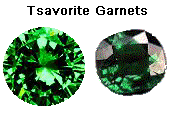 ... When comparing like stones, what you want to look for is the overall light return, the brilliance and sparkle of the gem. It is entirely possible to look at two gems with the same size and coloring, but one having much more brilliance and sparkle than the other. This is the result of cutting.
... When comparing like stones, what you want to look for is the overall light return, the brilliance and sparkle of the gem. It is entirely possible to look at two gems with the same size and coloring, but one having much more brilliance and sparkle than the other. This is the result of cutting.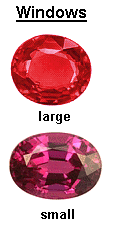 ... One thing to pay special attention to is "windowing." That is where light passes straight through the center, rather than being reflected back. It is easy to spot; the center will be much lighter than the outside of the gem and have no flashes of light. Some windows are small; others are quite large and hideous.
... One thing to pay special attention to is "windowing." That is where light passes straight through the center, rather than being reflected back. It is easy to spot; the center will be much lighter than the outside of the gem and have no flashes of light. Some windows are small; others are quite large and hideous.... This is another example of something that might look good in the store, but someday you will compare it with a well cut gem and be disappointed with your purchase.
... Cabochons are easier to judge. Begin by checking the polish under magnification. Then hold the stone a short distance from your head and rotate it slowly. Notice how the light passes across the surface. On a well cut gem, it will flow smoothly from one side to the other. If it is poorly shaped the light will not flow smoothly, but snake across the surface. Surface irregularities and poorly polished areas will also show up this way.
Carat
... Simply put, larger stones are less common than small ones. Hence, they demand a higher price per carat. For example, a quarter-carat topaz may cost $60 per carat, or $15. A half-carat topaz, (with the same color, clarity and cutting grades,) might cost $100 per carat, or $50. A full carat topaz would cost $200.... Choosing the right size is a personal matter. For the bold, dynamic individual, a large gem mirrors their personality. On the other hand, small stones are better suited to someone with delicate and feminine tastes. Most people will fall in between these two extremes.
... When budget is a strong factor, smaller stones have a significant advantage. Not only do they cost less per weight, the amount of gem you see is disproportionate to their size. The reason is that volume goes up faster than the outside dimensions. For example, a half carat, round diamond measures 5 mm in diameter, a ¾ carat diamond 6 mm, and a full carat 6.5 mm. From a casual observation, the half and ¾ carat stones, or the ¾ and full carat stones look to be about the same size, but the price difference can be considerable.
... Small gems are often clustered to give the illusion of more gemstone. Seven 1.6 mm diamonds, set close together, will take up as much space as a whole carat diamond. If set on white gold, it is hard to distinguish the separate stones, hence these are often called "illusion settings".
 ... While these seven stones approach the eye appeal of a one carat diamond, they only weigh .14 carats. Considering that the price per carat is also much lower, the cost difference is significant. A cluster ring would be in the hundreds of dollars, rather than the thousands.
... While these seven stones approach the eye appeal of a one carat diamond, they only weigh .14 carats. Considering that the price per carat is also much lower, the cost difference is significant. A cluster ring would be in the hundreds of dollars, rather than the thousands.... Colored stones are often clustered for the same reason: you get a lot more visible gem for less money. If your budget doesn't allow for your first choice in a gem, consider a setting with several smaller gems. With the right piece, you may find just the look and emotional appeal you wanted and at a price you can afford.
Conclusion
... This guide is intended to help you understand the factors that go into grading gemstones. You have learned that the term "quality" has to do with the rarity of a feature, not that it is necessarily better than something else. What is best for you may be smaller or lighter colored than the top grade.... Nature does not provide us with perfect gems, nor do lapidaries produce perfect work. In addition, you are not likely to be able to afford your first choice in gems. There are always compromises to be made. When shopping for a gem, you need to find what suits your personality best, as well as fitting it to your budget. The final and most important factor is the joy you get from your gem.
by Don Clark CSM IMG

No comments:
Post a Comment